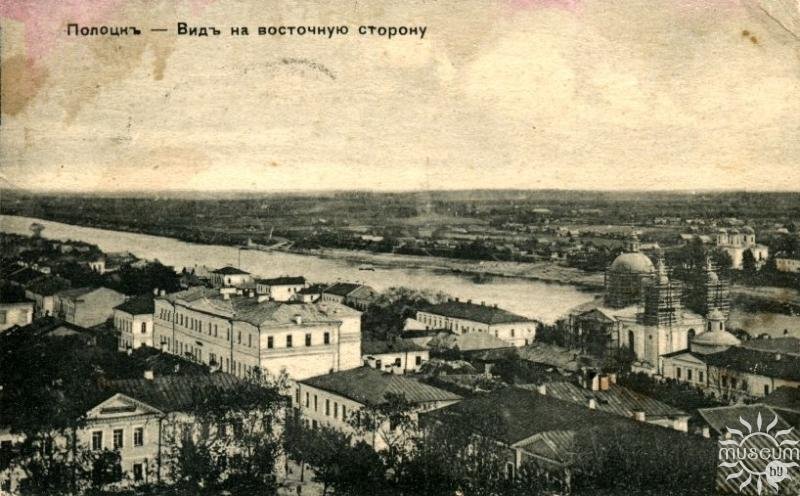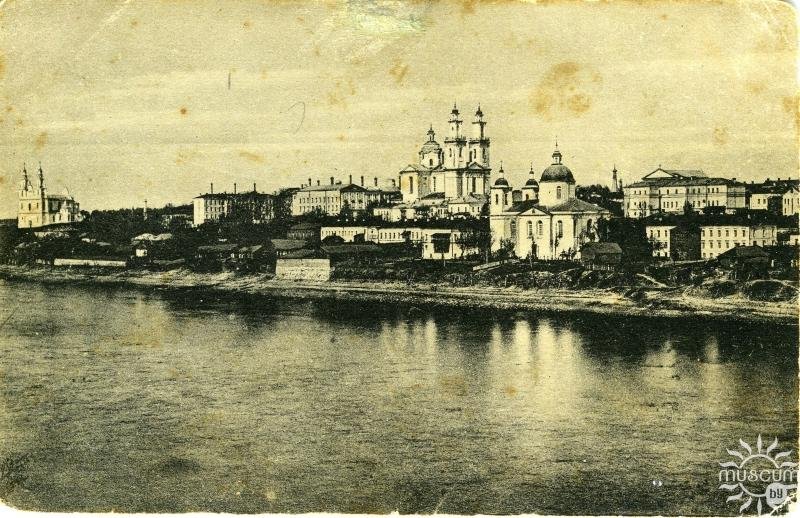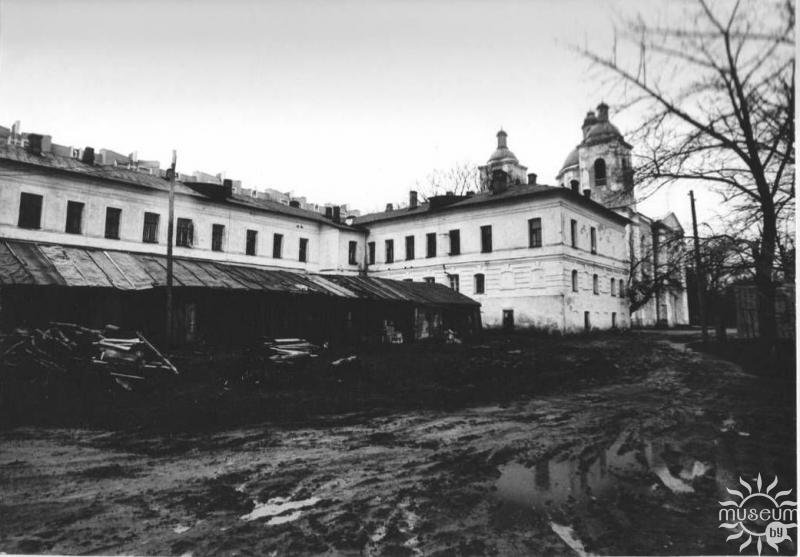
View of the building of Nizhne-Pokrovskaya St. from the side of the Western Dvina (late XIX— early XX cc.)

View of Polotsk Epiphany Monastery (late 19th — early 20th centuries)

The courtyard area of the former monastic cells of the Epiphany Monastery. View from the south (photo, 1986)
Nizhne-Pokrovskaya Street is one of the oldest streets in Polotsk. Historical sources confirm its existence already in the second half of the 11th — beginning of the 12th century. From the 13th century the street was densely populated, served as one of the main streets in the city, it was crossed by the Dvina River to the city markets, churches, synagogues, Catholic and Orthodox monasteries were located on it, the richest and most influential citizens lived there.
The first known name of this street was Velikaya Street. In the last quarter of the 18th century (in connection with the construction of St. Pokrovskaya Church) it was renamed into Nizhne-Pokrovskaya Street, in 1919 — into Lenin Street, and in 2008 the street again returned the name Nizhne-Pokrovskaya. It received its current direction in accordance with the classicist plan of Polotsk developed and approved in the late 18th century, which gave the layout of the historical center of the city the features of regularity.
House No. 22 on Nizhne-Pokrovskaya Street is a building of former monastic cells of the Epiphany Monastery. The monument, built in the second half of the 18th century, is an example of the Baroque with elements of classicism.
Polotsk Epiphany Monastery was founded in 1582. For a long time the monastery was the main center of Orthodoxy in the city.
Historical documents testify that in 1633 Prince Lev Samuil Oginsky and the justice of the peace Sevastyan Mirsky allocated a plot of land on Velikaya Street (modern Nizhne-Pokrovskaya Street) for the construction of a fraternal school and a theater at the Epiphany Monastery. From 1656 to 1659 the famous Belarusian writer and teacher Simeon Polotsky taught at the fraternal school.
Originally the monastery buildings (dwelling and church) were wooden and were repeatedly rebuilt after fires (1683, 1757). The Epiphany Church was built in stone in 1761-1779, and the existing today stone building of monastic cells — in the second half of the 18th century on the donations of Catherine II, who visited the monastery in 1780. Historical sources date the beginning of the construction of stone dwelling buildings to 1783. There is an opinion that the great master of the Classicist era Giacomo Quarenghi may have taken part in the design of the monastery buildings.
The wing of the L-shaped two-storey building oriented along the Nizhne-Pokrovskaya Street housed the brother cells, the warm church of St. Catherine was located in the corner part, the smaller wing housed the abbot's quarters and the refectory. In 1803 in the main monastery building on the second floor was located the church of St. Euphrosyne.
During the Patriotic War of 1812. The Epiphany Monastery was heavily looted. In the following decades of the 19th century the building of the residential building was repeatedly repaired (in 1817, 1832-1836, 1861-1863).
In 1792-1812 the existing building housed an almshouse, from 1879 its lower floor was partially adapted for apartments, and from 1881 to 1890 a free women's school operated there.
Until the October Revolution the residential building of the fraternal school was used for the needs of the Epiphany Monastery, and in 1922 the monastery was first attached to St. Nicholas Cathedral, and soon it was abolished. In the 20s of the 20th century in the building of the former fraternal school was a military unit. From 1957 to the mid-1980s the two-storey building was a residential house, in one of the rooms of the first floor on the east facade was a store. In 1985, preliminary work began to study the building with a view to its restoration and adaptation for a museum. In 1990 the Museum of the Belarusian Book-Printing was opened here, and in 1994 — the Museum-Library of Simeon of Polotsk, which operate in the building today.
According to the Decree of the Council of Ministers of the Republic of Belarus from 14.05.2007 № 578 the ensemble of the Epiphany Monastery in Polotsk is included in the State list of Historical and Cultural Heritage of the Republic of Belarus.
